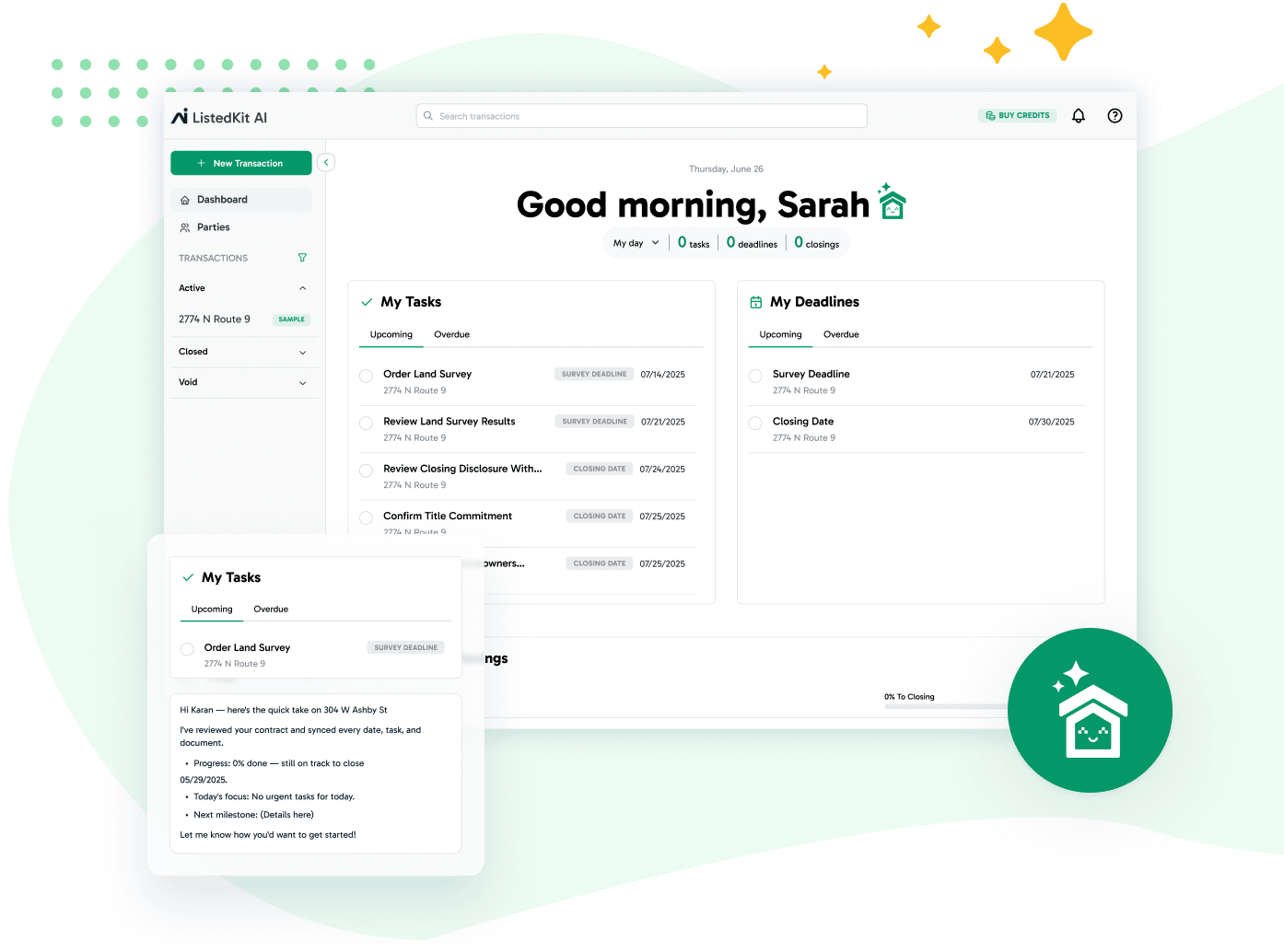How do you consistently keep real estate transactions on track when every region seems to play by a different rulebook? Compliance gaps can lead to delays, legal headaches, and unhappy clients—all of which undermine your credibility and efficiency. The ability to anticipate and adapt to regional real estate regulations is a necessity for transaction managers like you.
This guide provides actionable insights to tackle market-specific regulations, improve workflows, and refine your transaction management approach.
Regional Real Estate Regulations: What You Need to Know
Real estate regulations are not one-size-fits-all. Each region in the United States has its own laws and procedures that govern property transactions.
These rules cover everything from zoning laws and tax requirements to compliance documentation and disclosure forms. A deep understanding of these regulations is vital for transaction managers to ensure smooth processes and avoid complications.
- Zoning Laws. Dictate how a property can be used—residential, commercial, or mixed-use—and vary significantly by locality.
- Tax Codes. Include property taxes, transfer taxes, and special district taxes that can affect closing costs.
- Environmental Requirements. Some areas have strict laws regarding flood zones, protected habitats, or soil quality assessments.
Examples of Market-Specific Regulations
- Flood Zones in Houston. Properties in flood-prone areas require compliance with the National Flood Insurance Program (NFIP). This includes obtaining FEMA-compliant insurance, verifying details on the Flood Insurance Rate Map (FIRM), and adhering to local building codes based on Base Flood Elevations (BFEs).
- Transaction managers must communicate the importance of a flood insurance policy and how flood history can affect property value and risk assessments.
- Tools like the FEMA Map Service Center can provide updates on effective flood maps and identify properties within dam break inundation zones.
- Special Utility Districts in Texas. Many properties fall under the jurisdiction of special utility districts.
- These districts may impose additional taxes or fees, which impact the overall service charge rate for utilities.
- Understanding how utility easements affect a property’s value is essential for accurate disclosures.
Disclaimer: While tools like the FEMA Map Service Center provide valuable data on flood zones and effective flood maps, please confirm all information with local officials to ensure it reflects the most precise and up-to-date regulations.
The Role of Transaction Managers
Transaction managers are responsible for navigating these regional requirements to prevent delays, unexpected costs, and legal issues. For instance:
- Using flood maps and collaborating with community officials to confirm compliance in flood-prone areas.
- Reviewing local ordinances to ensure that properties meet zoning and building code requirements.
- Working with title companies to confirm there are no liens or encumbrances tied to tax or service districts.
Asking the Right Questions: Identifying Regional-Specific Details
Addressing regional-specific details ensures smoother transactions and minimizes surprises. For example:
- Failing to verify proper flood openings in a property can lead to higher flood insurance rates or denial of coverage under a private flood insurance policy.
- Overlooking spillway design flood requirements for properties near reservoirs can result in hefty fines or project delays.
Proactive questioning strengthens your reputation and reassures clients that every aspect of the transaction has been thoroughly evaluated.
Questions for Real Estate Agents
Real estate agents are a critical resource for uncovering regional nuances. Asking the right questions can provide clarity and prevent roadblocks:
- Flood-Specific Queries
- Is the subject property located in a designated flood zone?
- Does the property require flood insurance, and what are the typical flood insurance rates for the area?
- Are there ongoing updates to the Flood Insurance Study or National Flood Hazard Layer that may affect the property’s flood risk?
- Zoning and Compliance Questions
- What local zoning restrictions or ordinances should we be aware of?
- Are there environmental risks, like recurrent flooding or chronic inundation, that could complicate the transaction?
Questions for Clients
Clients often have insights about a property’s history or potential regulatory issues. Asking them focused questions ensures you address every detail:
- Has this property been affected by repetitive flooding or chronic water damage?
- Have there been recent renovations, and do they comply with local permitting laws?
- What is the flood risk of the property, and are there any federal resources or private programs available to offset insurance costs?
Staying Informed: Building Regional Expertise
Adapting to regional real estate regulations demands a proactive approach to staying informed.
The key is to combine reliable resources with strong professional relationships, ensuring you’re always prepared for the nuances of each transaction. Here’s how to put these strategies into action:
Leveraging Local Resources
Understanding regional nuances starts with utilizing available resources. Some effective strategies include:
- Collaborate with Regional Experts:
- Work with local title companies, appraisers, and inspectors. These professionals often have first-hand knowledge of local regulations, including flood-related requirements.
- Partner with coastal planning district commissions for properties in coastal or flood-prone areas.
- Use Federal Tools:
- The Map Service Center and Flood Insurance Rate Maps (FIRMs) provide crucial data on flood zones, individual flood risk, and community mitigation efforts.
- Leverage resources from agencies like the U.S. Army Corps of Engineers and the Natural Resources Conservation Service to evaluate property risk in specific regions.
Tracking Market Trends
To stay ahead of changes, it’s vital to monitor regional market trends and policy updates:
- Subscribe to newsletters or reports tailored to local real estate markets.
- Track zoning law revisions, tax adjustments, or flood map updates that could impact property transactions.
- Follow developments in programs like the Community Rating System that reward flood-prone communities for implementing preventative measures.
Building Relationships with Local Experts
Strong networks enhance your ability to anticipate changes and address region-specific challenges:
- Maintain relationships with agents, local vendors, and regional commissions to get early insight into changes in flood maps or tax codes.
- Collaborate with community officials to understand ongoing projects, like feasible flood prevention sites or updates to inundation zone maps.
Tools and Strategies for Compliance Management
With the variety of real estate regulations across different areas, transaction managers must adopt systems and strategies that enhance accuracy and reduce errors.
By leveraging innovative tools and implementing structured workflows, you can confidently meet compliance requirements while staying adaptable to regional updates.
Here’s how to apply these methods effectively:
Use Technology for Compliance Management
Technology can simplify the complex world of regional real estate transactions:
- Document Management. Tools like ListedKit enable transaction managers to organize and track compliance paperwork efficiently. For example, create a repository of region-specific forms, such as flood certifications or property disclosures.
- Flood Risk Monitoring. Use digital tools to analyze the chance of flooding for properties in at-risk areas. Combine data from effective flood maps and reports from federal agencies like FEMA to provide accurate assessments.
Creating Standard Operating Procedures (SOPs)
Developing SOPs tailored to regional requirements ensures you follow consistent workflows across transactions:
- Include detailed checklists for compliance steps, such as verifying flood damage history or identifying whether a property falls in a dam break inundation zone.
- Use templates for frequently required documents, like private flood insurance coverage agreements or tax disclosures.
Perform Regular Audits
To stay aligned with evolving regulations, conduct periodic audits:
- Review processes for managing region-specific risks, such as recurrent flooding or zoning ordinance changes.
- Assess whether your workflows account for updates to the Flood Insurance Rate Map or National Flood Hazard Layer.
By combining technology with structured workflows and regular reviews, you can minimize errors and maintain compliance with regional regulations.
Enhancing the Transaction Process: Key Takeaways for Success
Each step you take toward improving communication and attention to detail contributes to building trust and long-term success in your role. Here’s how to refine your approach for the best results:
Proactive Communication
Clear communication with stakeholders is essential for managing regional real estate requirements:
- Clients. Explain upfront how regional regulations, like flood zone compliance or special utility taxes, might affect their purchase.
- Agents. Provide checklists that outline necessary steps for property-specific compliance, such as ensuring alignment with National Flood Insurance Program standards.
Attention to Detail
The success of a transaction often hinges on meticulous attention to region-specific requirements:
- Confirm compliance with local flood prevention measures, such as proper flood openings or base flood elevation standards.
- Verify that the property meets the latest zoning restrictions and tax requirements.
Leverage Technology Like ListedKit
Tools like ListedKit help ensure accuracy and improve transaction speed:
- Automate task management for region-specific workflows.
- Centralize communication to keep clients and agents updated on compliance milestones.
By implementing these practices, you’ll create a smoother transaction process that builds trust and ensures long-term success in your role.
Streamline Regional Compliance
with ListedKit
Manage region-specific workflows, track documents,
and stay on top of milestones—all in one place.
Master Regional Real Estate Regulations Like a Pro
Becoming proficient in regional real estate regulations isn’t just a skill—it’s the backbone of smooth and successful transactions. As a transaction manager, your ability to adapt to varying local rules, anticipate compliance requirements, and guide all parties with clarity makes a lasting impact. Here’s a quick recap of the key strategies that empower you to excel:
- Understand Regional Specifics. From zoning laws to flood risk assessments, knowing the nuances of local regulations prevents costly errors and delays.
- Ask Targeted Questions. Proactively address potential compliance gaps by asking agents and clients about flood zones, tax implications, and property history.
- Leverage Local Resources. Build connections with title companies, appraisers, and federal tools like FEMA’s Map Service Center to stay informed on updates and risks.
- Adopt Technology. Tools like ListedKit help streamline document tracking, monitor compliance milestones, and enhance collaboration.
- Create Clear Workflows. Develop region-specific checklists, templates, and SOPs to
- maintain consistency across transactions.
By prioritizing these steps, you can transform regulatory complexity into an opportunity to deliver exceptional client experiences and efficient transaction processes.
For more actionable tips and to stay up-to-date with the latest best practices in transaction coordination, subscribe to our newsletter below!




